Abstract
The synthesis and release of human prolactin (hPRL) in the human fetus was assessed by radioimmunoassay analysis of the content and concentration of hPRL in 82 pituitary glands and the concentration of serum hPRL in 47 fetuses of gestational age 68 days to term. Fetal hPRL exhibited parallelism with the reference standard (Lewis 203-1). hPRL was detected by 68 days of gestation (10 wk), the earliest fetal pituitary gland studied; 8 out of 33 pituitaries had a prolactin (PRL) content above 2.0 ng between 10-15 wk gestation. The mean ocntent of PRL in the pituitary gland increased sharply from 14.8 plus or minus 4.6 ng at 15-19 wk to 405 plus or minus 142 ng at 20-24 wk and 542 plus or minus ng at 25-29 wk gestation. By term, the mean content was 2,039 plus or minus 459 (range 493-3,689) and the mean concentration 15.9 plus or minus 2.4 ng/mg (range 7-20). There was a significant positive correlation (P less than 0.001) between the hPRL and human growth hormone (hGH) content of fetal pituitary glands; at term the hPRL/hGH ratio was 1/290. The concentration of serum hPRL between 12 and 24 wk ranged from 2.9 to 67 ng/ml, mean 19.5 plus or minus 2.5 ng/ml )n = 21); by 26 wk fetal serum hPRL increased sharply and attained levels of 300-500 ng/ml in late gestation. At delivery, the mean plasma concentration of hPRL was 167 plus or minus 14.2 ng/ml in 36 umbilical venous specimens and 111.8 plus or minus 12.3 ng/ml in the matched maternal venous specimens. No correlation between serum hPRL and the pituitary content or concentration of hPRL was demonstrable in 12 matched fetal specimens. In five anencephalic infants, umbilical venous hPRL levels were between 65 and 283 ng/ml. In two anencephalic infants, thyrotropin releasing factor (TRF) (200 mug IV) evoked a rise in serum hPRL in one patient from 43 to 156 ng/ml at 30 min, and in the other from 65 to 404 ng/ml at 120 min. In both patients, plasma thyroid-stimulating hormone (TSH) rose from undetectable base-line levels to peak levels of 97 and 380 muU/ml, respectively. The pattern of change in serum hPRL in the human fetus contrasts sharply with that of serum hGH, luteinizing hormone, or follicle-stimulating hormone. These observations in the fetus and in anencephalic infants suggest that the striking elevation of serum PRL in the fetus is neither mediated by a putative PRL releasing factor or by TRF, nor is a consequence of suppression or absence of PRL release inhibiting factor alone, as a functional hypothalamus is not required to attain the high PRL concentration at term. Several lines of evidence support the view that high plasma estrogen levels characteristic of gestation act directly on the fetal anterior hypophysis to stimulate PRL secretion or to sensitize the secretory mechanism of the lactotrope, increasing its responsiveness to other stimuli.
Full text
PDF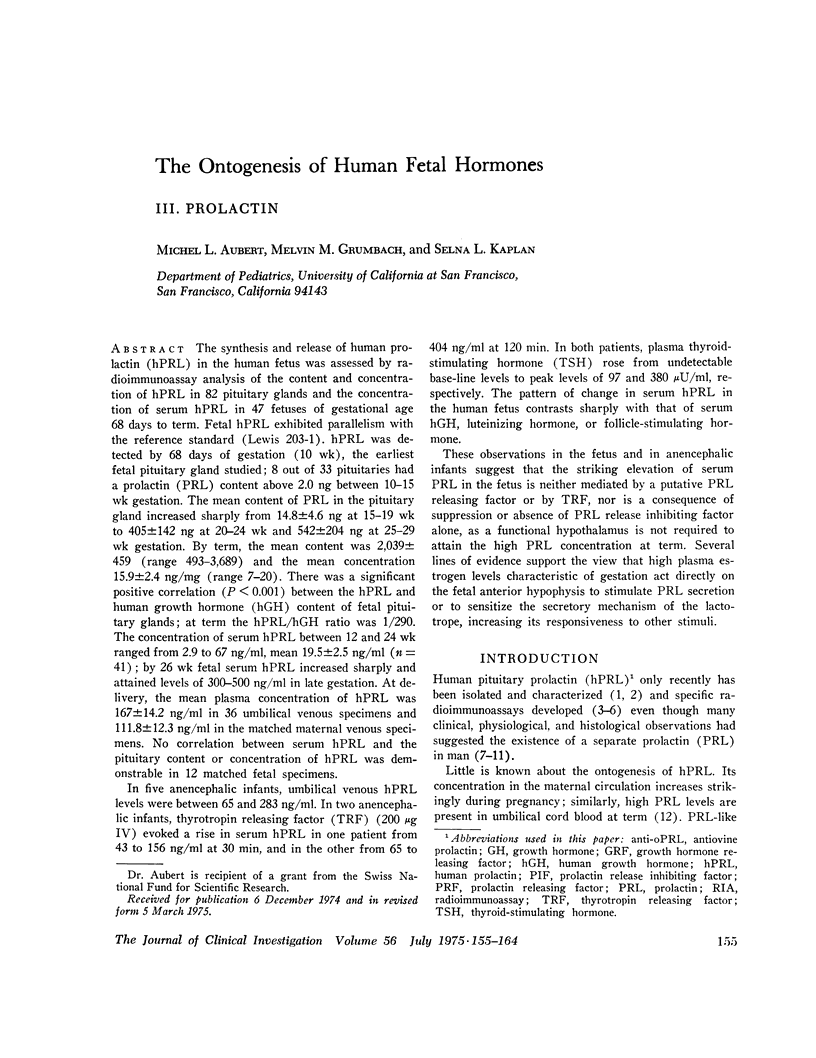
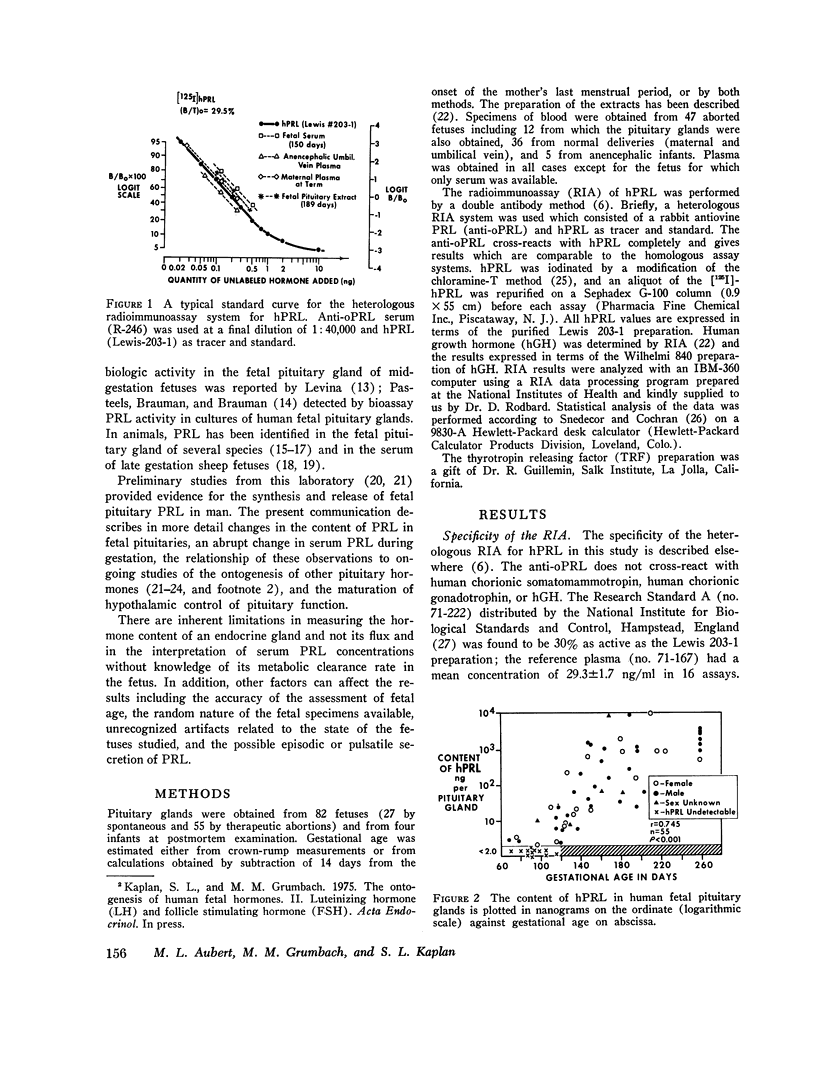
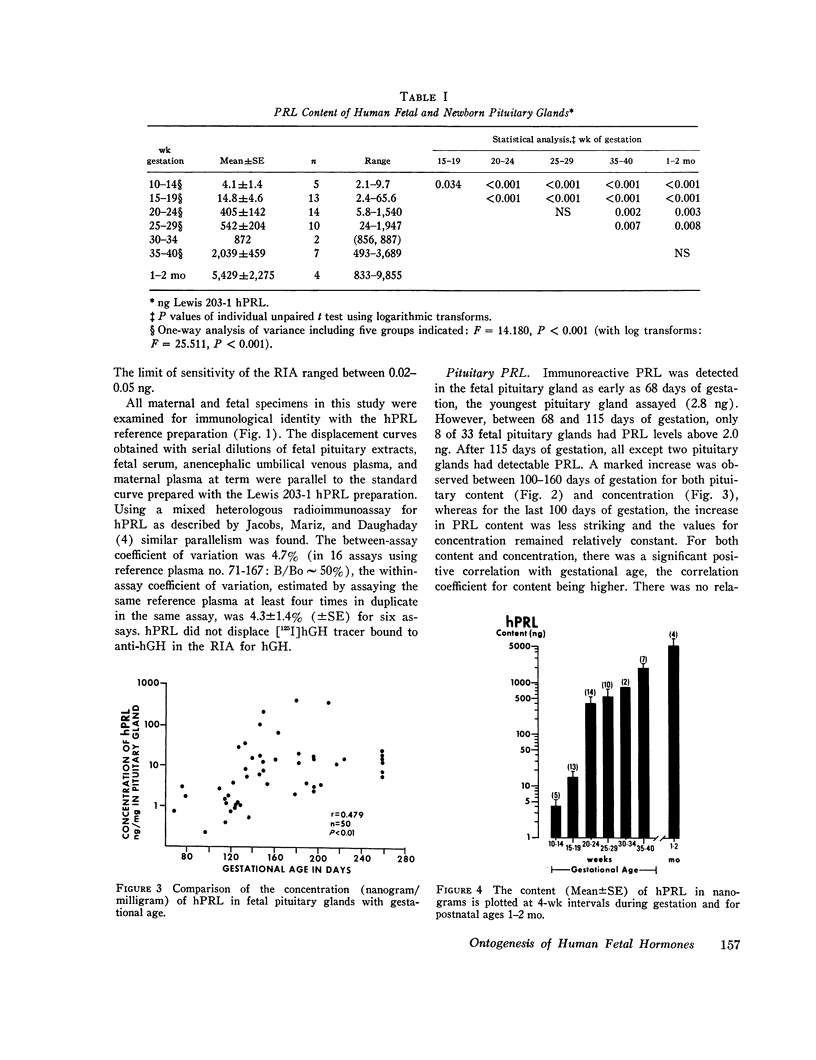
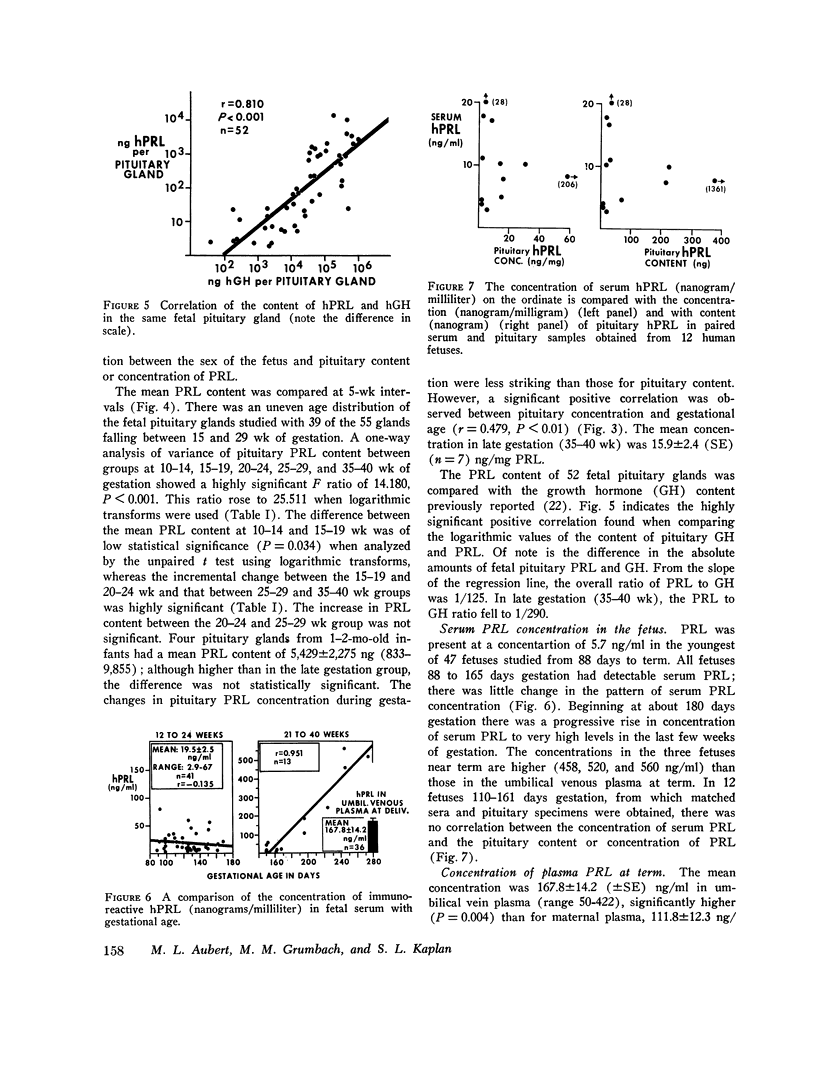
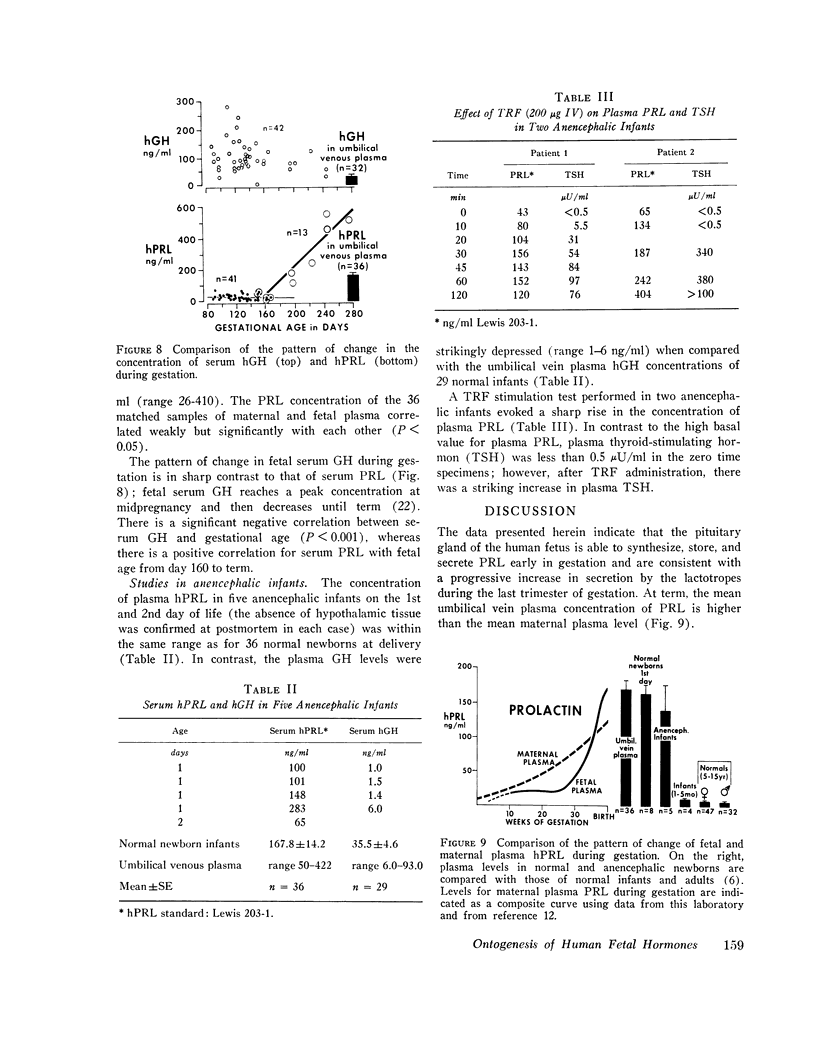

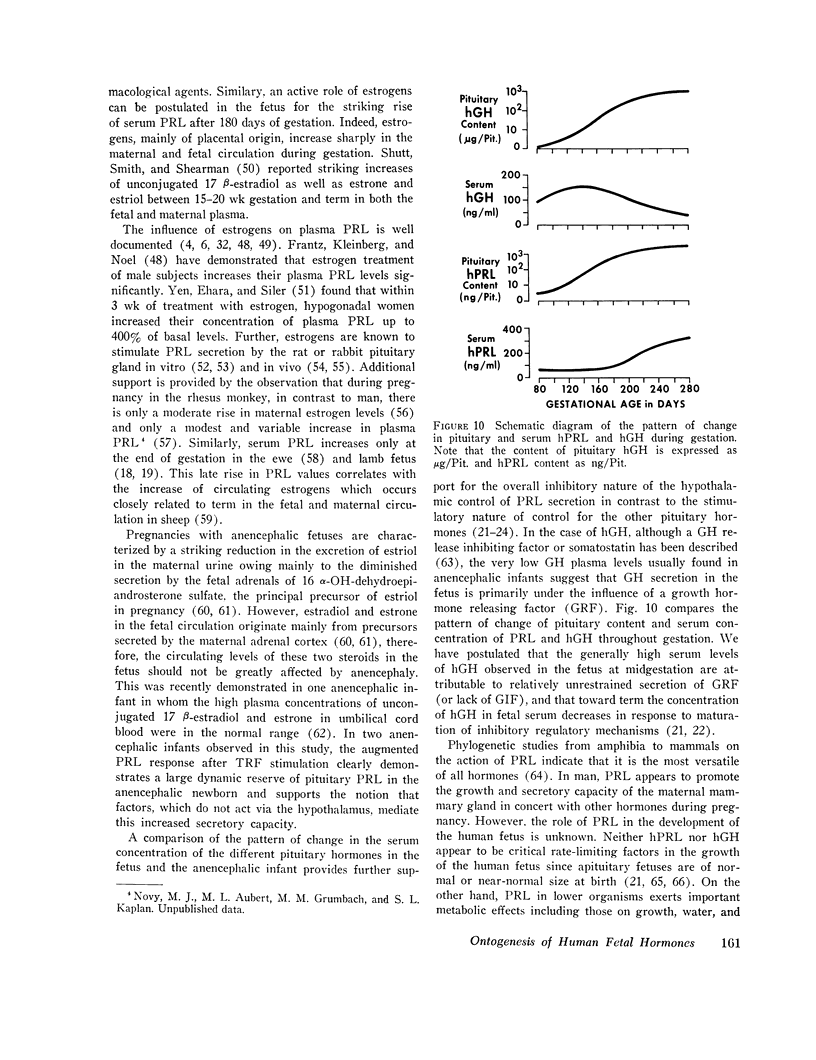
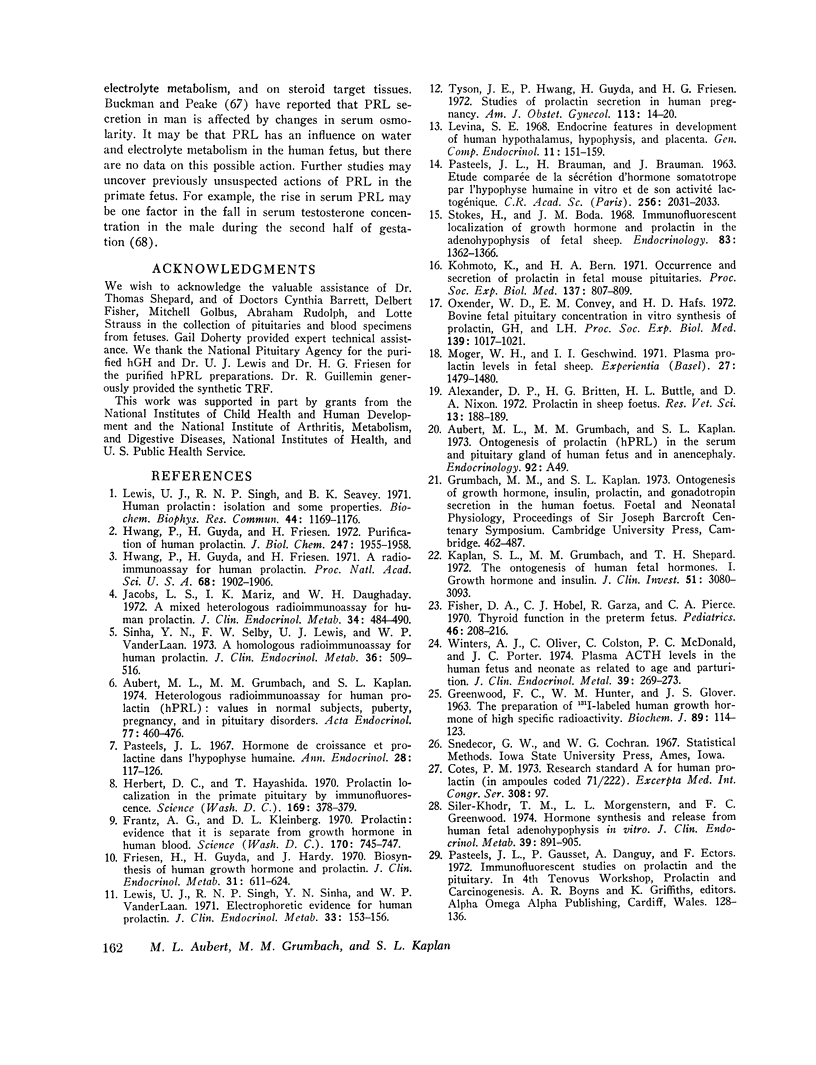

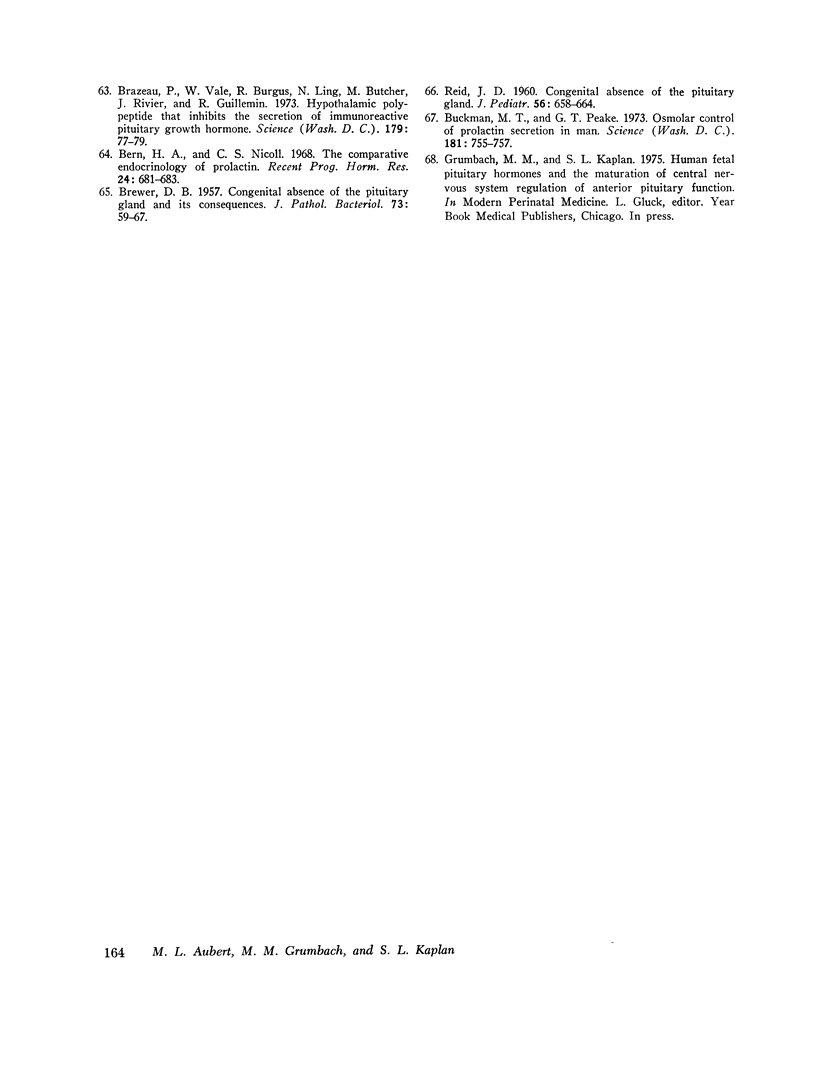
Selected References
These references are in PubMed. This may not be the complete list of references from this article.
- Alexander D. P., Britton H. G., Buttle H. L., Nixon D. A. Impermeability of the sheep placenta towards endogenous prolactin. Res Vet Sci. 1973 Mar;14(2):271–272. [PubMed] [Google Scholar]
- Alexander D. P., Britton H. G., Buttle H. L., Nixon D. A. Prolactin in the sheep foetus. Res Vet Sci. 1972 Mar;13(2):188–189. [PubMed] [Google Scholar]
- Alexander D. P., Britton H. G., Corker C. S., Naftolin F., Nixon D. A. Plasma luteinizing hormone and oestrogen in foetal and maternal sheep. J Endocrinol. 1973 Feb;56(2):331–332. doi: 10.1677/joe.0.0560331. [DOI] [PubMed] [Google Scholar]
- Aubert M. L., Grumbach M. M., Kaplan S. L. Heterologous radioimmunoassay for plasma human prolactin (hPRL); values in normal subjects, puberty, pregnancy and in pituitary disorders. Acta Endocrinol (Copenh) 1974 Nov;77(3):460–476. doi: 10.1530/acta.0.0770460. [DOI] [PubMed] [Google Scholar]
- BEN-DAVID M., DIKSTEIN S., SULMAN F. G. EFFECT OF DIFFERENT STEROIDS ON PROLACTIN SECRETION IN PITUITARY-HYPOTHALAMUS ORGAN CO-CULTURE. Proc Soc Exp Biol Med. 1964 Nov;117:511–513. doi: 10.3181/00379727-117-29623. [DOI] [PubMed] [Google Scholar]
- Bern H. A., Nicoll C. S. The comparative endocrinology of prolactin. Recent Prog Horm Res. 1968;24:681–720. doi: 10.1016/b978-1-4831-9827-9.50019-8. [DOI] [PubMed] [Google Scholar]
- Blackwell R. E., Guillemin R. Hypothalamic control of adenohypophysial secretions. Annu Rev Physiol. 1973;35:357–390. doi: 10.1146/annurev.ph.35.030173.002041. [DOI] [PubMed] [Google Scholar]
- Bowers C. Y., Friesen H. G., Hwang P., Guyda H. J., Folkers K. Prolactin and thyrotropin release in man by synthetic pyroglutamyl-histidyl-prolinamide. Biochem Biophys Res Commun. 1971 Nov;45(4):1033–1041. doi: 10.1016/0006-291x(71)90441-4. [DOI] [PubMed] [Google Scholar]
- Brazeau P., Vale W., Burgus R., Ling N., Butcher M., Rivier J., Guillemin R. Hypothalamic polypeptide that inhibits the secretion of immunoreactive pituitary growth hormone. Science. 1973 Jan 5;179(4068):77–79. doi: 10.1126/science.179.4068.77. [DOI] [PubMed] [Google Scholar]
- Buckman M. T., Peake G. T. Osmolar control of prolactin secretion in man. Science. 1973 Aug 24;181(4101):755–757. doi: 10.1126/science.181.4101.755. [DOI] [PubMed] [Google Scholar]
- Challis J. R., Davies I. J., Benirschke K., Hendrickx A. G., Ryan K. J. The concentrations of progesterone, estrone and estradiol-17 beta in the peripheral plasma of the rhesus monkey during the final third of gestation, and after the induction of abortion with PGF 2 alpha. Endocrinology. 1974 Aug;95(2):547–553. doi: 10.1210/endo-95-2-547. [DOI] [PubMed] [Google Scholar]
- Chen C. L., Amenomori Y., Lu K. H., Voogt J. L., Meites J. Serum prolactin levels in rats with pituitary transplants or hypothalamic lesions. Neuroendocrinology. 1970;6(4):220–227. doi: 10.1159/000121946. [DOI] [PubMed] [Google Scholar]
- Davis S. L., Reichert L. E., Jr, Niswender G. D. Serum levels of prolactin in sheep as measured by radioimmunoassay. Biol Reprod. 1971 Apr;4(2):145–153. doi: 10.1093/biolreprod/4.2.145. [DOI] [PubMed] [Google Scholar]
- Fisher D. A., Hobel C. J., Garza R., Pierce C. A. Thyroid function in the preterm fetus. Pediatrics. 1970 Aug;46(2):208–216. [PubMed] [Google Scholar]
- Foley T. P., Jr, Jacobs L. S., Hoffman W., Daughaday W. H., Blizzard R. M. Human prolactin and thyrotropin concentrations in the serums of normal and hypopituitary children before and after the administration of synthetic thyrotropin-releasing hormone. J Clin Invest. 1972 Aug;51(8):2143–2150. doi: 10.1172/JCI107021. [DOI] [PMC free article] [PubMed] [Google Scholar]
- Frantz A. G., Kleinberg D. L., Noel G. L. Studies on prolactin in man. Recent Prog Horm Res. 1972;28:527–590. [PubMed] [Google Scholar]
- Frantz A. G., Kleinberg D. L. Prolactin: evidence that it is separate from growth hormone in human blood. Science. 1970 Nov 13;170(3959):745–747. doi: 10.1126/science.170.3959.745. [DOI] [PubMed] [Google Scholar]
- Friesen H., Guyda H., Hardy J. The biosynthesis of human growth hormone and prolactin. J Clin Endocrinol Metab. 1970 Dec;31(6):611–624. doi: 10.1210/jcem-31-6-611. [DOI] [PubMed] [Google Scholar]
- GREENWOOD F. C., HUNTER W. M., GLOVER J. S. THE PREPARATION OF I-131-LABELLED HUMAN GROWTH HORMONE OF HIGH SPECIFIC RADIOACTIVITY. Biochem J. 1963 Oct;89:114–123. doi: 10.1042/bj0890114. [DOI] [PMC free article] [PubMed] [Google Scholar]
- Goluboff L. G., Ezrin C. Effect of pregnancy on the somatotroph and the prolactin cell of the human adenohypophysis. J Clin Endocrinol Metab. 1969 Dec;29(12):1533–1538. doi: 10.1210/jcem-29-12-1533. [DOI] [PubMed] [Google Scholar]
- Guyda H. J., Friesen H. G. Serum prolactin levels in humans from birth to adult life. Pediatr Res. 1973 May;7(5):534–540. doi: 10.1203/00006450-197305000-00007. [DOI] [PubMed] [Google Scholar]
- Hayek A., Driscoll S. G., Warshaw J. B. Endocrine studies in anencephaly. J Clin Invest. 1973 Jul;52(7):1636–1641. doi: 10.1172/JCI107343. [DOI] [PMC free article] [PubMed] [Google Scholar]
- Herbert D. C., Hayashida T. Prolactin localization in the primate pituitary by immunofluorescence. Science. 1970 Jul 24;169(3943):378–379. doi: 10.1126/science.169.3943.378. [DOI] [PubMed] [Google Scholar]
- Hwang P., Guyda H., Friesen H. A radioimmunoassay for human prolactin. Proc Natl Acad Sci U S A. 1971 Aug;68(8):1902–1906. doi: 10.1073/pnas.68.8.1902. [DOI] [PMC free article] [PubMed] [Google Scholar]
- Hwang P., Guyda H., Friesen H. Purification of human prolactin. J Biol Chem. 1972 Apr 10;247(7):1955–1958. [PubMed] [Google Scholar]
- Jacobs L. S., Mariz I. K., Daughaday W. H. A mixed heterologous radioimmunoassay for human prolactin. J Clin Endocrinol Metab. 1972 Mar;34(3):484–490. doi: 10.1210/jcem-34-3-484. [DOI] [PubMed] [Google Scholar]
- Josimovich J. B., Weiss G., Hutchinson D. L. Sources and disposition of pituitary prolactin in maternal circulation, amniotic fluid, fetus and placenta in the pregnant rhesus monkey. Endocrinology. 1974 May;94(5):1364–1371. doi: 10.1210/endo-94-5-1364. [DOI] [PubMed] [Google Scholar]
- Kaplan S. L., Grumbach M. M., Friesen H. G., Costom B. H. Thyrotropin releasing factor (TRF) effect on secretion of human pituitary prolactin and thyrotropin in children and in idiopathic hypopituitary dwarfism: further evidence for hypophysiotropic hormone deficiencies. J Clin Endocrinol Metab. 1972 Dec;35(6):825–830. doi: 10.1210/jcem-35-6-825. [DOI] [PubMed] [Google Scholar]
- Kaplan S. L., Grumbach M. M., Shepard T. H. The ontogenesis of human fetal hormones. I. Growth hormone and insulin. J Clin Invest. 1972 Dec;51(12):3080–3093. doi: 10.1172/JCI107135. [DOI] [PMC free article] [PubMed] [Google Scholar]
- Kenny F. M., Angsusingha K., Stinson D., Hotchkiss J. Unconjugated estrogens in the perinatal period. Pediatr Res. 1973 Oct;7(10):826–831. doi: 10.1203/00006450-197310000-00006. [DOI] [PubMed] [Google Scholar]
- Komoto K., Bern H. A. Occurrence and secretion of prolactin in fetal mouse pituitaries. Proc Soc Exp Biol Med. 1971 Jul;137(3):807–809. doi: 10.3181/00379727-137-35672. [DOI] [PubMed] [Google Scholar]
- Levina S. E. Endocrine features in development of human hypothalamus, hypophysis, and placenta. Gen Comp Endocrinol. 1968 Aug;11(1):151–159. doi: 10.1016/0016-6480(68)90116-0. [DOI] [PubMed] [Google Scholar]
- Lewis U. J., Singh R. N., Seavey B. K. Human prolactin: isolation and some properties. Biochem Biophys Res Commun. 1971 Sep;44(5):1169–1176. doi: 10.1016/s0006-291x(71)80209-7. [DOI] [PubMed] [Google Scholar]
- Lewis U. J., Singh R. N., Sinha Y. N., VanderLaan W. P. Electrophoretic evidence for human prolactin. J Clin Endocrinol Metab. 1971 Jul;33(1):153–156. doi: 10.1210/jcem-33-1-153. [DOI] [PubMed] [Google Scholar]
- MACDONALD P. C., SITERI P. K. ORIGIN OF ESTROGEN IN WOMEN PREGNANT WITH AN ANENCEPHALIC FETUS. J Clin Invest. 1965 Mar;44:465–474. doi: 10.1172/JCI105160. [DOI] [PMC free article] [PubMed] [Google Scholar]
- MacLeod R. M., Lehmeyer J. E. Studies on the mechanism of the dopamine-mediated inhibition of prolactin secretion. Endocrinology. 1974 Apr;94(4):1077–1085. doi: 10.1210/endo-94-4-1077. [DOI] [PubMed] [Google Scholar]
- Meites J., Lu K. H., Wuttke W., Welsch C. W., Nagasawa H., Quadri S. K. Recent studies on functions and control of prolactin secretion in rats. Recent Prog Horm Res. 1972;28:471–526. [PubMed] [Google Scholar]
- Moger W. H., Geschwind I. I. Plasma prolactin levels in fetal sheep. Experientia. 1971 Dec 15;27(12):1479–1480. doi: 10.1007/BF02154303. [DOI] [PubMed] [Google Scholar]
- NICOLL C. S., MEITES J. PROLACTIN SECRETION IN VITRO: EFFECTS OF GONADAL AND ADRENAL CORTICAL STEROIDS. Proc Soc Exp Biol Med. 1964 Nov;117:579–583. doi: 10.3181/00379727-117-29643. [DOI] [PubMed] [Google Scholar]
- Oxender W. D., Convey E. M., Hafs H. D. Bovine fetal pituitary concentration and in vitro synthesis of prolactin, GH, and LH. Proc Soc Exp Biol Med. 1972 Mar;139(3):1017–1021. doi: 10.3181/00379727-139-36288. [DOI] [PubMed] [Google Scholar]
- Pasteels J. L. Hormone de croissance et prolactine dans l'hypophyse humaine. Ann Endocrinol (Paris) 1967 Jan-Feb;28(1):117–126. [PubMed] [Google Scholar]
- RAMIREZ V. D., MCCANN S. M. INDUCTION OF PROLACTIN SECRETION BY IMPLANTS OF ESTROGEN INTO THE HYPOTHALAMO-HYPOPHYSIAL REGION OF FEMALE RATS. Endocrinology. 1964 Aug;75:206–214. doi: 10.1210/endo-75-2-206. [DOI] [PubMed] [Google Scholar]
- REID J. D. Congenital absence of the pituitary gland. J Pediatr. 1960 May;56:658–664. doi: 10.1016/s0022-3476(60)80341-1. [DOI] [PubMed] [Google Scholar]
- Shutt D. A., Smith I. D., Shearman R. P. Oestrone, oestradiol-17beta and oestriol levels in human foetal plasma during gestation and at term. J Endocrinol. 1974 Feb;60(2):333–341. doi: 10.1677/joe.0.0600333. [DOI] [PubMed] [Google Scholar]
- Siiteri P. K., MacDonald P. C. Placental estrogen biosynthesis during human pregnancy. J Clin Endocrinol Metab. 1966 Jul;26(7):751–761. doi: 10.1210/jcem-26-7-751. [DOI] [PubMed] [Google Scholar]
- Siler-Khodr T. M., Morgenstern L. L., Greenwood F. C. Hormone synthesis and release from human fetal adenohypophyses in vitro. J Clin Endocrinol Metab. 1974 Nov;39(5):891–905. doi: 10.1210/jcem-39-5-891. [DOI] [PubMed] [Google Scholar]
- Sinha Y. N., Selby F. W., Lewis U. J., VanderLaan W. P. A homologous radioimmunoassay for human prolactin. J Clin Endocrinol Metab. 1973 Mar;36(3):509–516. doi: 10.1210/jcem-36-3-509. [DOI] [PubMed] [Google Scholar]
- Stokes H., Boda J. M. Immunofluorescent localization of growth hormone and prolactin in the adenohypophysis of fetal sheep. Endocrinology. 1968 Dec;83(6):1362–1366. doi: 10.1210/endo-83-6-1362. [DOI] [PubMed] [Google Scholar]
- Takahara J., Arimura A., Schally A. V. Suppression of prolactin release by a purified porcine PIF preparation and catecholamines infused into a rat hypophysial portal vessel. Endocrinology. 1974 Aug;95(2):462–465. doi: 10.1210/endo-95-2-462. [DOI] [PubMed] [Google Scholar]
- Tashjian A. H., Jr, Barowsky N. J., Jensen D. K. Thyrotropin releasing hormone: direct evidence for stimulation of prolactin production by pituitary cells in culture. Biochem Biophys Res Commun. 1971 May 7;43(3):516–523. doi: 10.1016/0006-291x(71)90644-9. [DOI] [PubMed] [Google Scholar]
- Turkington R. W., Underwood L. E., Van Wyk J. J. Elevated serum prolactin levels after pituitary-stalk section in man. N Engl J Med. 1971 Sep 23;285(13):707–710. doi: 10.1056/NEJM197109232851302. [DOI] [PubMed] [Google Scholar]
- Tyson J. E., Friesen H. G. Factors influencing the secretion of human prolactin and growth hormone in menstrual and gestational women. Am J Obstet Gynecol. 1973 Jun 1;116(3):377–387. doi: 10.1016/s0002-9378(15)31297-7. [DOI] [PubMed] [Google Scholar]
- Tyson J. E., Hwang P., Guyda H., Friesen H. G. Studies of prolactin secretion in human pregnancy. Am J Obstet Gynecol. 1972 May 1;113(1):14–20. doi: 10.1016/0002-9378(72)90446-2. [DOI] [PubMed] [Google Scholar]
- Winters A. J., Oliver C., Colston C., MacDonald P. C., Porter J. C. Plasma ACTH levels in the human fetus and neonate as related to age and parturition. J Clin Endocrinol Metab. 1974 Aug;39(2):269–273. doi: 10.1210/jcem-39-2-269. [DOI] [PubMed] [Google Scholar]
- Yen S. S., Ehara Y., Siler T. M. Augmentation of prolactin secretion by estrogen in hypogonadal women. J Clin Invest. 1974 Feb;53(2):652–655. doi: 10.1172/JCI107600. [DOI] [PMC free article] [PubMed] [Google Scholar]


